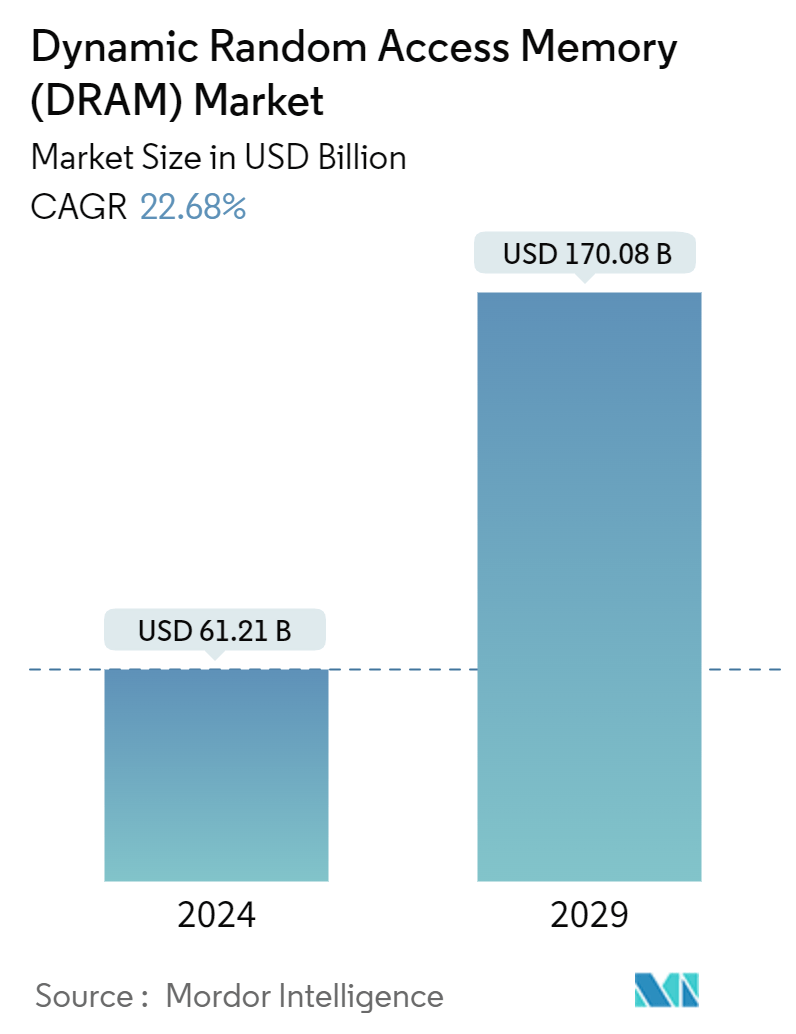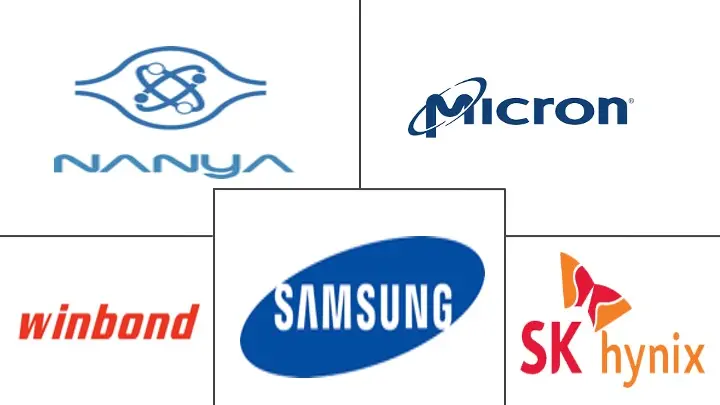Market Size of Dynamic Random Access Memory (DRAM) Industry

| Study Period | 2019 - 2029 |
| Market Size (2024) | USD 61.21 Billion |
| Market Size (2029) | USD 170.08 Billion |
| CAGR (2024 - 2029) | 22.68 % |
| Fastest Growing Market | North America |
| Largest Market | North America |
Major Players
*Disclaimer: Major Players sorted in no particular order |
Dynamic Random Access Memory (DRAM) Market Analysis
The Dynamic Random Access Memory Market size is estimated at USD 61.21 billion in 2024, and is expected to reach USD 170.08 billion by 2029, growing at a CAGR of 22.68% during the forecast period (2024-2029). In terms of shipment volume, the market is expected to grow from 17.49 billion units in 2024 to 31.03 billion units by 2029, at a CAGR of 12.16% during the forecast period (2024-2029).
- Semiconductor memory, called dynamic random access memory (DRAM), stores and processes data or program code necessary for a computer processor's functioning. This type of RAM is commonly found in personal computers, smartphones, ADAS systems, smartwatches, workstations, and servers.
- The growing adoption of generative AI boosts the demand for fast processing and highly efficient DRAM solutions. For instance, Micron Technology partnered with Qualcomm Technologies Inc. to accelerate generative AI at the edge for smartphones. The company shipped production samples of the low-power double data rate 5X (LPDDR5X) memory to Qualcomm in October 2023. The LPDDR5X memory operates at a 9.6 Gbps speed grade, delivering the speed and performance the mobile ecosystem needs to unleash the power of AI at the edge.
- Micron LPDDR5X provides advanced power-saving capabilities for mobile users using its innovative, 1β process node technology. Also, in September 2023, SK Hynix presented a prototype of AI accelerator card, AiMX1, based on the high-speed, low-power, and high-density memory solution GDDR6-AiM at the AI hardware & edge AI Summit 2023 in California. AiMX1 is expected to significantly contribute to developing high-performance, data-intensive, and AI-based systems.
- Datacenter demand for DRAM is projected to grow significantly, which will lift overall DRAM demand annually. Artificial intelligence and other cutting-edge technologies like streaming, gaming, and autonomous vehicles will continue to drive robust demand for data centers. This will drive innovation in data center architecture and technology as operators strive to provide the capacity that supports the increased power density required by high-performance computing. Integrating artificial intelligence, the Internet of Things, and 5G will be a massive tailwind to the demand for computing and DRAM.
- Worldwide smartphone shipments declined significantly in FY 2023 compared to FY 2022 due to decreased consumer spending, economic downturn, and increased inflation. Smartphone vendors such as Samsung, Apple, Xiaomi, and Oppo (including One Plus) witnessed declining smartphone sales. Following smartphones, tablets, and PCs/laptops, demand fell in FY 2023 due to weakened consumer spending, interest rates, and increasing uncertainty due to ongoing geopolitical tensions. These factors will restrict the growth of the DRAM market.
- The COVID-19 pandemic had a significant impact on the DRAM market, both on the demand side and the supply side. Lockdowns and factory shutdowns worldwide contributed to the supply shortage, but many of these impacts are expected to be temporary. Governments worldwide are taking steps to support the semiconductor industries, which could lead to a recovery.
Dynamic Random Access Memory (DRAM) Industry Segmentation
Dynamic random access memory, called DRAM, is used in various computing and electronic devices like PCs, smartphones, music players, laptops, netbooks, and tablet computers. The scope of the study focuses on the market analysis of DRAM semiconductors sold across the globe, and market sizing encompasses the revenue generated through DRAM sold by various market players to end-user industries. The study also tracks the key market parameters, underlying growth influencers, and major vendors operating in the industry, which will support the market estimations and growth rates during the forecast period. The study further analyzes the overall impact of COVID-19 on the ecosystem.
The DRAM market is segmented by architecture (DDR3, DDR4, DDR5, and DDR2), applications (smartphones/tablets, PC/laptops, data centers, graphics, consumer products, and automotive), and geography (the United States, Europe, Korea, China, Taiwan, the Rest of Asia-Pacific, and the Rest of the World). The report offers market forecasts and sizes in value (USD) for all the above segments.
| By Architecture | |
| DDR3 | |
| DDR4 | |
| DDR5 | |
| DDR2/Others Architectures |
| By Application | |
| Smartphones/Tablets | |
| PC/Laptop | |
| Datacenter | |
| Graphics | |
| Consumer Products | |
| Automotive | |
| Other Applications |
| By Geography | |
| United States | |
| Europe | |
| Korea | |
| China | |
| Taiwan | |
| Rest of Asia-Pacific | |
| Rest of the World |
Dynamic Random Access Memory (DRAM) Market Size Summary
The dynamic random access memory (DRAM) market is poised for substantial growth, driven by its critical role in various applications such as personal computers, smartphones, advanced driver-assistance systems, smartwatches, workstations, and servers. The increasing adoption of generative AI and the demand for fast, efficient DRAM solutions are significant factors propelling market expansion. Partnerships, like that of Micron Technology and Qualcomm Technologies, highlight the industry's focus on enhancing mobile processing capabilities. Additionally, the rise in data center demand, fueled by advancements in artificial intelligence, streaming, gaming, and autonomous vehicles, is expected to further boost DRAM consumption. The integration of AI, IoT, and 5G technologies is anticipated to be a major driver, supporting the need for high-performance computing and advanced memory solutions.
Despite challenges such as declining smartphone shipments and economic factors affecting consumer spending, the DRAM market is expected to recover and grow. The COVID-19 pandemic's impact on supply chains has been partially mitigated by government support for the semiconductor industry. The market is witnessing a shift in focus from mobile to server DRAM products, reflecting the growing enterprise use of cloud computing and high-performance computing applications. Innovations in memory technology, such as Micron's DDR5 chip and Samsung's LPCAMM, are set to enhance performance in data centers and consumer electronics. The market's competitive landscape is dominated by major players like Samsung Electronics, SK Hynix, and Micron, who are investing in next-generation chips to maintain their market positions.
Dynamic Random Access Memory (DRAM) Market Size - Table of Contents
-
1. MARKET INSIGHTS
-
1.1 Market Overview
-
1.2 Industry Attractiveness - Porter's Five Forces Analysis
-
1.2.1 Bargaining Power of Suppliers
-
1.2.2 Bargaining Power of Buyers
-
1.2.3 Threat of New Entrants
-
1.2.4 Threat of Substitute Products
-
1.2.5 Intensity of Competitive Rivalry
-
-
1.3 Impact of Macroeconomic Factors on the DRAM Industry
-
-
2. MARKET SEGMENTATION
-
2.1 By Architecture
-
2.1.1 DDR3
-
2.1.2 DDR4
-
2.1.3 DDR5
-
2.1.4 DDR2/Others Architectures
-
-
2.2 By Application
-
2.2.1 Smartphones/Tablets
-
2.2.2 PC/Laptop
-
2.2.3 Datacenter
-
2.2.4 Graphics
-
2.2.5 Consumer Products
-
2.2.6 Automotive
-
2.2.7 Other Applications
-
-
2.3 By Geography
-
2.3.1 United States
-
2.3.2 Europe
-
2.3.3 Korea
-
2.3.4 China
-
2.3.5 Taiwan
-
2.3.6 Rest of Asia-Pacific
-
2.3.7 Rest of the World
-
-
Dynamic Random Access Memory (DRAM) Market Size FAQs
How big is the Dynamic Random Access Memory Market?
The Dynamic Random Access Memory Market size is expected to reach USD 61.21 billion in 2024 and grow at a CAGR of 22.68% to reach USD 170.08 billion by 2029.
What is the current Dynamic Random Access Memory Market size?
In 2024, the Dynamic Random Access Memory Market size is expected to reach USD 61.21 billion.

